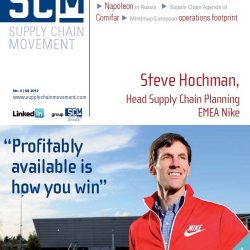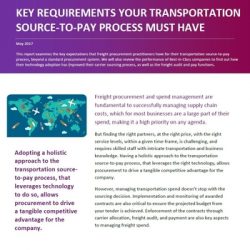Supply Chain Movement Q4: social supply networks

CONTENTS
Theme: Social Supply Networks
7 | News & Background
8 | Profile Steve Hochman, Nike
Nike, the world’s leading designer, marketer and seller of athletic footwear, apparel, equipment, accessories and services, sets the bar as high as the sporting superstars who endorse its products. With the likes of Ronaldo, Iniesta, Rooney and Torres, adorning the European head office walls in Hilversum, the Netherlands, you can’t help but be inspired and energised. The campus radiates sport, fitness and well being, enhanced by the full size athletic track and other sporting facilities for the more than 1500 people who work here.
14 | Management article Social supply networks
Nowadays, traditional linear supply chains have evolved into complex collaborative networks. The simple supplier-customer relationship is almost a thing of the past and it is not unusual for companies to be supplier, customer, partner and/or competitor simultaneously. As companies realise that they cannot innovate on their own, partnerships are becoming commonplace. Such partnerships are usually based on mutual trust between two individuals which then has to be extended through the rest of their organisations. This leads to the creation of ‘social supply networks’, both at individual and at company level.
20 | Facts & Figures Social media in the supply chain
23 | Insight growth Eastern Europe
The supply chains in Europe are set to change considerably in the years ahead. The strongest economic growth can be found in the eastern part of Europe. New logistics hubs are emerging in Central Europe and more goods flows from Asia will travel via the Black Sea or, as land freight, via the Trans-Siberian rail route. These developments are clearly visible on the European supply chain map which has been co-produced by Buck Consultants and Supply Chain Movement.
24 | Supply Chain Map Europe
27 | Book reviews
28 | Supply Chain History: Napoleon in Russia
Major technical innovations were at a standstill at the end of the eighteenth century and during the Napoleonic Wars (1796-1815). Yet general Napoleon Bonaparte, later emperor, knew just how to put his stamp on military history, quite indelibly, by conquering the majority of Europe. Innovation in the supply chain played a pivotal role in this, yet in the end, it was his neglect of the logistics that led to his downfall (1812).
32 | Mindmap European operations footprint
35 | Tools & Technology
37 | Supply Chain Agenda of Stefano Novaresi









